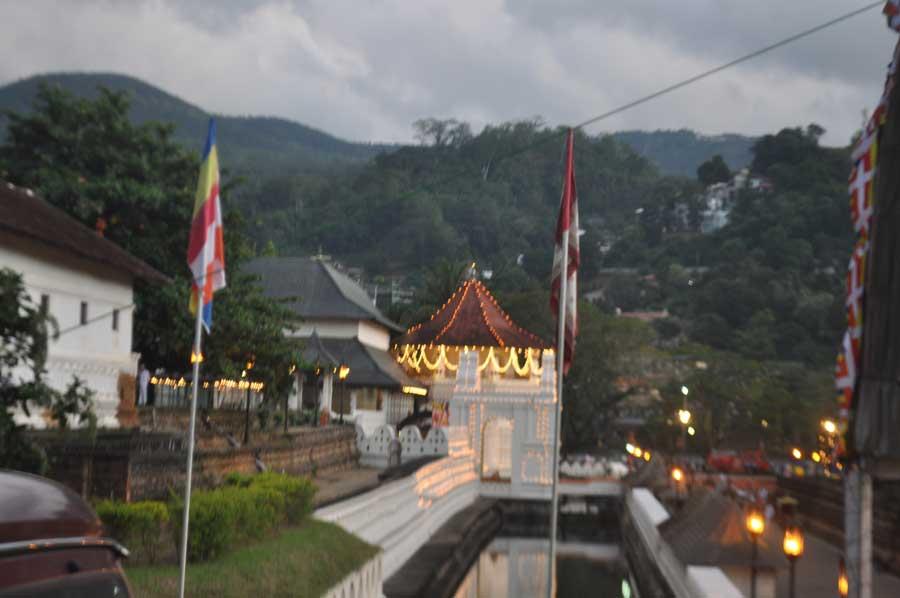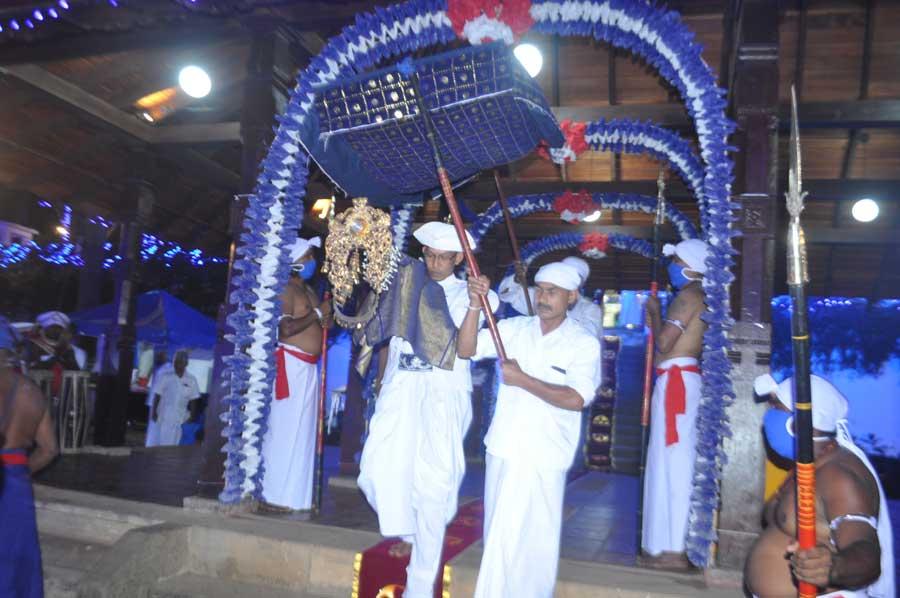Reply To:
Name - Reply Comment

A distant view of the Maligawa
Kandy is one of the few cities where one could experience the ancient glory of Sri Lanka. The echoes of the  drums, ceremonial rituals and the pageantry are all centred at one place - Kandy or the glory of Senkadagalapura. During the month of July and August every year, historical Kandy Esala Maha Perahera takes place for twelve days. In contrast to usual massive crowd, this year it was limited to a few people and also a
drums, ceremonial rituals and the pageantry are all centred at one place - Kandy or the glory of Senkadagalapura. During the month of July and August every year, historical Kandy Esala Maha Perahera takes place for twelve days. In contrast to usual massive crowd, this year it was limited to a few people and also a
few elephants.
Esela Perahera procession is not completed without people or devotees. One would think it would have been better to limit Perahera rituals only to Devales and Maligawa rather than taking the procession out to public without people
being there.
However Perahera is considered as a State event when it is taken out on the streets. Initiated by ancient Kings, conducting Perahera is believed to be an act of bestowing blessing on people. The Sacred Tooth Relic was the personal property of all kings and it is believed that anyone who holds the Relic is undoubtedly the administrator of the country.
There have been instances when the Perahera was stopped by the British and even by the kings leaving it only
for rituals.
After the 1817 Kandyan Rebellion against the British by the Kandy Chiefs in power, Kandy Esala Perahera was not allowed to be taken on the streets, except within the respective Devales and the Sri Dalada Maligawa premises. It was only after eleven years in 1826, that the Perahera was held on the streets.
It is also recorded that Governor Edward Barnes personally participated at the Perahera riding a white horse to show the people that the power of the people is within himself. He also knew that the Sacred Tooth Relic was the personal property of the King and was not shown to the people.
Major Forbes in his “Eleven Years in Ceylon “ gives an eye witness account of the Perahera which he states commenced on May 29, 1828. Then again the Perahera was stopped by the British during the 1915 Muslim -Sinhala riots and the Perahera commenced again four years after in 1919. Yet the normal rites, practices and the Perahera’s were held within the Devales and the Sri Dalada Maligawa. “ Ves “ dancing was introduced into the Sri Dalada Maligawa Perahera by Diywadana Nilame C.B. Nugawela . “Ves” before was considered a ritualistic art.
John Davy’s account of the Perahera is as follows “The King who before was only a spectator, now took an active interest during the five days that the ‘Randoli-Beyama’ lasted, regularly joining the evening procession in his golden Chariot drawn by eight horses. According to the natives, this part of the Perahera was extremely magnificent, the Chief’s vying with each other in the splendour of dress and in the multitudes of their attendants and every party concerned, and the King in Particular, using the utmost exertions to make the spectacle as brilliant as impressive as possible. But to proceed, on the night of the full moon, the relic of Boodhoo for the first time joined the nocturnal procession, at the conclusion of which it was not returned to the Maligawa but deposited in the ‘Adhana Maluwa’, a temple neighborhood of Kandy.
The more reliable account of the Perahera is given by Millewa Dissava of Vellassa and the account appeared in the Government Gazette of August 19, 1817. The description refers to the ‘Randoli’ Perahera. But that description differs from the present manner since much has changed.
Dissawe points out that the Randoli’s or Planquins are taken in front of the Perahera, but it is not so now. They take the rear. He also speaks that the Royal ladies went with the Randoli’s, but today only those who are engaged in service of the Devale goes with the Randoli. Most people miss the ‘Randoli’ and they are prevented from making offering into the Randoli’s, as they pass them or go up to the Randoli, due to the
security measures.
Millewe Dissave refers thus “I commences with the bringing from the Devales the Randoli’s or Palanquins four in number, each dedicated to a particular Goddess and each furnished with a golden goblet and a sword similarly dedicated a palanquins form a part of the evening procession and hen carried by the people after the bows and arrows, but in the procession at night they take the lead the women belonging to the Devales, who attended the first part of the ceremony attend this also to which every other honour is due and is paid in the King’s time the daughters and young wives of the chiefs dressed in royal apparel given to them by his Majesty, alternatively accompanied the ‘Randoli ‘ of each Goddess.
So the Kandy Esala Perahera ends on August 4 with the water cutting ceremony and a visit to the President to inform him that Perahera was conducted successfully. If the Head of State was not available the Chiefs reported to the Government Agent as the Representative of the State, at his official residence.

The insignia of the God is brought down, this is at Sri Maha Vishnu Devale